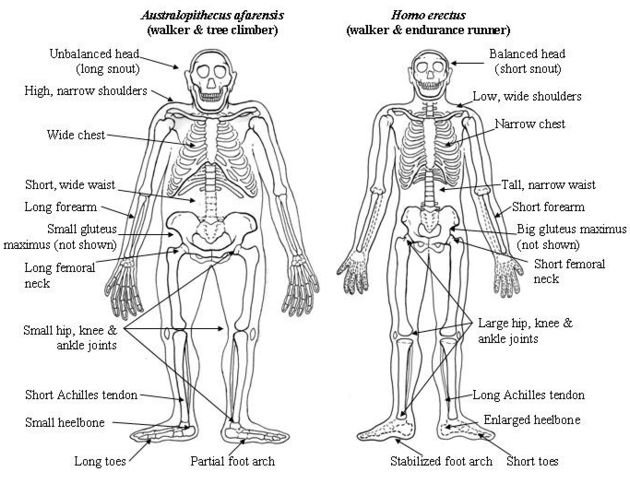IELTS Writing Task 1: Question
This IELTS Task 1 diagram is a great chance to practice your comparing skills. How many differences can you spot and which differences are most significant?
The diagram shows the skeletal systems of two ancestors of modern human beings.
Write a 150-word report for a university lecturer describing the diagram and making comparisons where relevant.
IELTS Writing Task 1: Model Answer
Variations in the skeletal systems of two early types of human are illustrated in this diagram. Overall, we can see that australopithecus afarensis had a heavier body and much longer arms, while homo erectus was slimmer and had more developed joints.
To begin with the upper half of the body, australopithecus afarensis had a much broader chest and waist than homo erectus, giving it a rounder appearance. The former had much longer arms and larger hands, which would have been useful for climbing trees.
As for the lower half of the body, we can see that homo erectus had proportionately longer legs and larger hip, knee and ankle joints. The feet of homo erectus were also smaller and more arched, with shorter toes. These differences meant that homo erectus was better suited to long-distance running.
In conclusion, we can see significant changes in the development of early humans from the diagram. Homo erectus is more similar to contemporary human beings with its long legs and arched feet. The physical differences are clearly related to differences in the lifestyles of tree climbers and endurance runners.
(183 words, IELTS 9.0)
Why does this Task 1 answer get an IELTS Band 9 score?
Task achievement: The model answer selects only the most important information from the Task 1 diagram and uses this to make several direct comparisons. The model answer also explains the link between the creatures’ respective lifestyles and their physical differences. The model answer is more than 150 words.
Coherence and cohesion: The model answer is divided into clear paragraphs with a logical separation between the body paragraphs. There is a general overview in paragraph 1 and a summary in paragraph 4. A reference link, the former, is used to avoid over-repetition of complex scientific names.
Lexical resource: The model answer adds more vocabulary not in the diagram such as lifestyle, proportionately, suited, appearance and contemporary. There are many examples of paraphrasing including wide > broad and endurance > long-distance.
Grammatical range and accuracy: The model answer uses a range of comparative structures accurately. The model answer also uses a range of grammatical forms to produce complex sentences. These include clauses beginning with with, which and -ing forms.
Teacher’s Notes
 You might panic when you see this IELTS Writing Task 1 diagram due to the number of words. However, it isn’t necessary to describe every feature. Instead, highlight only the most interesting points for comparison. In this example, we would definitely want to mention the width of the body and the length of the legs. A high-scoring answer will also include some kind of overview or general statement. In this case, the physical differences between our ancestors are clearer connected to their different lifestyles, as mentioned in the headings.
You might panic when you see this IELTS Writing Task 1 diagram due to the number of words. However, it isn’t necessary to describe every feature. Instead, highlight only the most interesting points for comparison. In this example, we would definitely want to mention the width of the body and the length of the legs. A high-scoring answer will also include some kind of overview or general statement. In this case, the physical differences between our ancestors are clearer connected to their different lifestyles, as mentioned in the headings.
